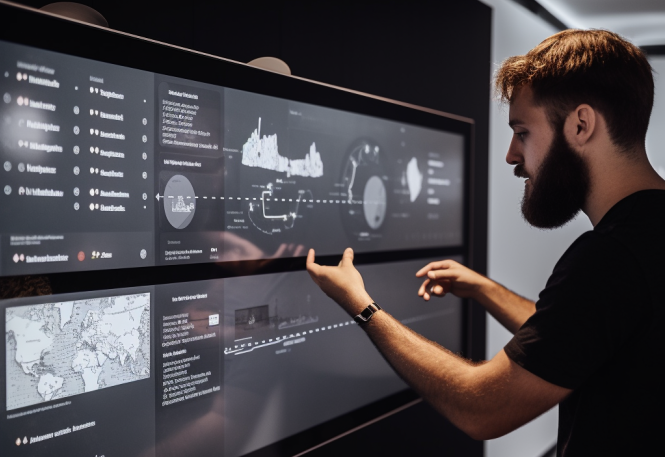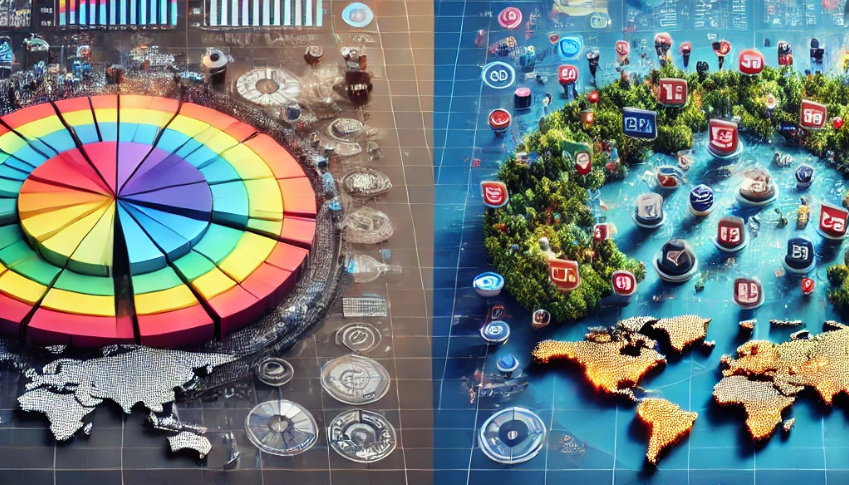In today’s complex business environment, understanding your competitive landscape is crucial for making informed strategic decisions. Competitive landscape visualization tools have emerged as powerful allies for businesses seeking to gain a clear picture of their market position and identify growth opportunities. These tools transform raw data into actionable insights, enabling leaders to navigate the complexities of their industries with confidence.
What is Competitive Landscape Visualization?
Competitive landscape visualization is the process of creating visual representations of a company’s competitive environment. This includes mapping out competitors, market trends, customer segments, and other factors that influence a business’s strategic position. By presenting complex data in a visually appealing and easily digestible format, these tools help decision-makers quickly grasp the dynamics of their industry and make more informed choices.
The importance of competitive landscape visualization cannot be overstated. In an era where data is abundant but insights are scarce, these tools provide a crucial bridge between information overload and strategic action. They allow businesses to:
- Identify emerging market trends and opportunities
- Understand competitor strengths and weaknesses
- Spot potential threats before they become critical
- Align resources with the most promising areas of growth
- Communicate complex market dynamics to stakeholders
Types of Competitive Landscape Visualization Tools
There are several categories of tools available for visualizing competitive landscapes, each with its own strengths and use cases:
- Market Mapping Tools: These tools create visual representations of market segments, competitor positions, and product offerings. They help businesses understand where they stand with competitors and identify underserved market niches.
- SWOT Analysis Tools: By visually representing strengths, weaknesses, opportunities, and threats, these tools provide a comprehensive view of a company’s strategic position.
- Competitor Analysis Tools: These platforms focus on gathering and visualizing data about specific competitors, including their products, pricing strategies, and market share.
- Industry Analysis Tools: Offering a broader view, these tools visualize overall industry trends, regulatory environments, and macroeconomic factors affecting the competitive landscape.
- Specialized Tools: Some tools focus on specific aspects of competitive intelligence, such as patent analysis or social media monitoring, providing deep insights into particular areas of interest.
Key Features of Effective Visualization Tools
The most powerful competitive landscape visualization tools share several key features:
- Data Integration: The ability to pull in data from multiple sources, including internal databases, public records, and third-party APIs, is crucial for creating a comprehensive view of the competitive landscape.
- Customizable Visualizations: Effective tools offer a range of visualization options, from simple charts and graphs to complex interactive maps, allowing users to choose the most appropriate format for their data.
- Collaboration Features: In today’s distributed work environments, tools that enable team members to collaborate on visualizations in real time are increasingly valuable.
- AI and Machine Learning Integration: Advanced tools use AI to identify patterns and trends that might be missed by human analysts, providing deeper insights and predictive capabilities.
- User-Friendly Interface: The best tools strike a balance between powerful features and ease of use, ensuring that non-technical users can create and interpret visualizations effectively.
Latest Trends in Competitive Landscape Visualization
The field of competitive landscape visualization is rapidly evolving, driven by advances in technology and changing business needs. Some of the most significant trends include:
- Real-Time Data Updates: Tools that can incorporate and visualize data in real-time are becoming increasingly popular, allowing businesses to respond quickly to market changes.
- Predictive Analytics: By leveraging historical data and machine learning algorithms, some tools now offer predictive capabilities, helping businesses anticipate future market trends.
- Natural Language Processing: Advanced tools are beginning to incorporate NLP capabilities, allowing users to interact with visualizations using natural language queries.
- Virtual and Augmented Reality: Some cutting-edge tools are exploring the use of VR and AR to create immersive, three-dimensional visualizations of competitive landscapes.
- Integration with Business Intelligence Platforms: Many visualization tools are now designed to integrate seamlessly with broader business intelligence ecosystems, providing a more holistic view of business performance.
Case Studies and Best Practices
Successful implementations of competitive landscape visualization tools abound across industries. For example, a leading e-commerce company used market mapping tools to identify underserved customer segments, leading to the development of new product lines that significantly boosted revenue. Similarly, a pharmaceutical firm leveraged patent analysis visualizations to identify promising areas for R&D investment, resulting in several breakthrough drugs.
However, not all implementations are successful. Common pitfalls include over-reliance on visualizations without critical analysis, failure to update data regularly, and choosing tools that are too complex for the organization’s needs.
Best practices for creating effective visualizations include:
- Start with clear objectives: Know what questions you’re trying to answer before creating visualizations.
- Use appropriate visualization types: Choose the right format for your data and audience.
- Keep it simple: Avoid cluttering visualizations with unnecessary information.
- Provide context: Ensure that viewers have the necessary background to interpret the visualization correctly.
- Update regularly: Competitive landscapes change quickly, so keep your visualizations current.
Market Outlook
The market for competitive landscape visualization tools is growing rapidly, driven by increasing competition across industries and the growing recognition of the value of data-driven decision-making. According to recent market research, the global competitive intelligence tools market is expected to reach $82.0 billion by 2027, growing at a CAGR of 14.9% from 2020 to 2027.
Key players in the market include established business intelligence firms as well as innovative startups. As the market matures, we’re likely to see increased consolidation, with larger players acquiring smaller, specialized firms to expand their capabilities.
Conclusion
Competitive landscape visualization tools have become indispensable for businesses seeking to navigate complex market environments. By transforming raw data into clear, actionable insights, these tools enable leaders to make more informed strategic decisions, identify new opportunities, and stay ahead of the competition.
As the field continues to evolve, businesses that effectively leverage these tools will be better positioned to thrive in an increasingly competitive global marketplace. Whether you’re a startup looking to disrupt an established industry or a multinational corporation seeking to maintain market leadership, investing in competitive landscape visualization capabilities should be a key priority.
Remember, the most successful companies don’t just react to their competitive landscape – they actively shape it. With the right visualization tools and strategies, your business can gain the insights needed to do just that.

When seeking assistance with creating impactful visualizations for investor presentations, many companies turn to Top Pitch Deck Firms for their expertise in crafting compelling visual narratives that effectively communicate competitive advantages and market opportunities.









